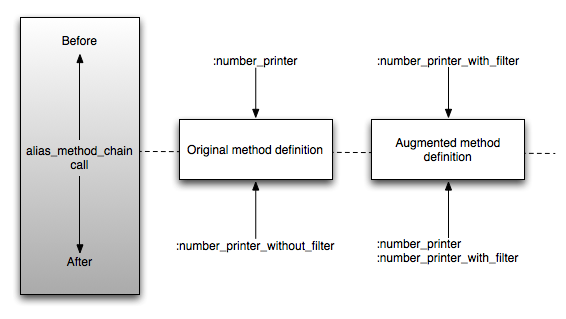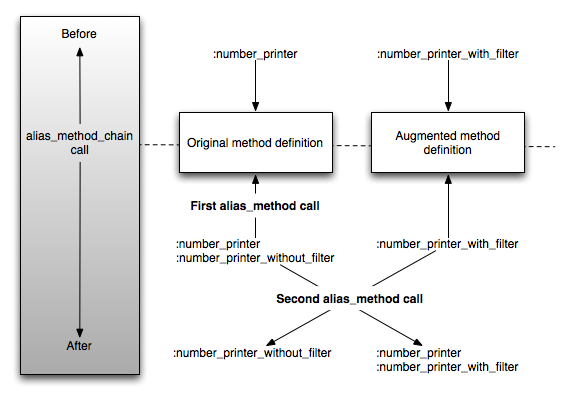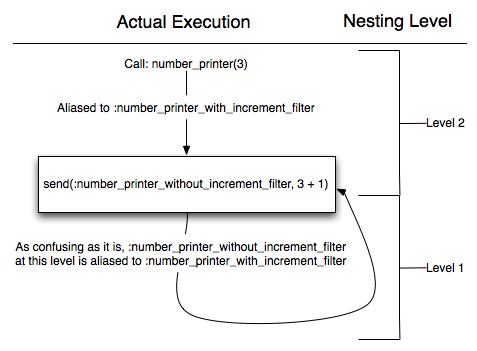Introduction
Rails provides a nifty utility in ActiveSupport called alias_method_chain. For those not familiar with it, it simplifies the task of “replacing” an already defined method with an augmented one. The new method is aliased to the name of the original method and the original method is aliased to some other name in order that it may still be referenced.
More succinctly, the following call:
alias_method_chain :number_printer, :filteris effectively the same as:
alias_method :number_printer_without_filter, :number_printer
alias_method :number_printer, :number_printer_with_filterFig. 1 illustrates how the alias_method_chain call changes references to the method definitions like so:
 Fig. 1: Results of alias_method_chain call.
Fig. 1: Results of alias_method_chain call.
Now the original method defined as :number_printer is referenced as :number_printer_without_filter. :number_printer now points to the method definition for :number_printer_with_filter, which can be referenced as either :number_printer or :number_printer_with_filter.
This implies that prior to the execution of the alias_method_chain call, you must define both methods :number_printer and :number_printer_with_filter.
Motivating Example
The ninja-decorators project relies heavily on alias_method_chain and its usage will be used as the example throughout the remainder of the article. ninja-decorators gives you before_filter, after_filter, and around_filter functionality outside of Rails controllers. With these methods you can handle cross-cutting concerns in a class located elsewhere in your Rails app or without having to use Rails at all. Using the standard examples of security and logging as cross-cutting concerns, we have something like the following:
around_filter :secure_around, [:number_printer]
around_filter :log_around, [:number_printer]Here, we want :log_around to decorate :number_printer with :secure_around applied. Internally, around_filter delegates to alias_method_chain to handle method decoration.
Problem
The problem with the implementation of alias_method_chain is one of definition order with regards to its two internal alias_method calls. If the new head of the chain is an enhancement of an existing method in the chain, there likely exists a coupling between the two. Since the alias_method_chain call is effectively atomic, however, this complicates how the two methods reference each other. Fig. 2 shows the intermittent states between each of the two alias_method calls made internally by alias_method_chain.
 Figure 2: Detailed breakdown of alias_method_chain mechanics.
Figure 2: Detailed breakdown of alias_method_chain mechanics.
:number_printer_without_filter will not exist until after the alias_method_chain call is complete. :number_printer_with_filter must exist before the alias_method_chain call can begin, otherwise the second alias_method call made internally will fail. As a consequence, :number_printer_with_filter must call :number_printer_without_filter dynamically. As long as you only use one level of alias_method_chain calls, this isn’t a problem. With multiple levels of chaining, however, dynamic calls like this fall apart.
To make the discussion a little more concrete, we’ll use the following example adapted from the ninja-decorators project. It is a bit contrived, but should serve well enough as a basis for discussion.
require 'activesupport'
class NumberFun
def self.around_filter(around_method, method_names)
method_names.each do |meth|
define_method("#{meth}_with_around_filter") do |*args|
send(around_method, *args) do |*ar_args|
send("#{meth}_without_around_filter", *ar_args)
end
end
alias_method_chain meth, :around_filter
end
end
def increment_filter(num)
yield(num + 1)
end
def number_printer(num)
puts num
end
def square_printer(num)
puts num * num
end
around_filter :increment_filter, [:number_printer, :square_printer]
end:number_printer and :square_printer are two simple methods. They take a number in and print out its value or its square, respectively. :increment_filter is a simple “around filter”; it augments a method by incrementing the input argument by 1 before executing the original method. Running both methods will produce the following in IRB:
>> NumberFun.new.number_printer 3
4
=> nil
>> NumberFun.new.square_printer 5
36
=> nilaround_filter is where all the hard work is being done and is where alias_method_chain is employed. It takes as its arguments a filter method name and a list of method names to decorate with that filter. For each method to decorate it defines the required “with” method for alias_method_chain. This newly defined method will call the filter method (:increment_filter in this case), which will in turn call the original, undecorated method (:number_printer_without_increment_filter or :square_printer_without_increment_filter) as a block. Once the “with” method is defined, alias_method_chain is called so that the original method name can be used to transparently call the newly decorated method.
While convoluted (don’t worry, it’s wrapped up a library), this approach will work dandily until you need to start decorating a method more than once. For the sake of the example, we’ll pretend that we actually want to increment each input argument as two. In reality, well’d likely want to apply a completely different filter. The outcome is precisely the same, but to keep things simple, we’ll just apply the :increment_filter twice:
around_filter :increment_filter, [:number_printer, :square_printer]
around_filter :increment_filter, [:number_printer, :square_printer]Running this through IRB again, we’d likely expect to see :number_printer print out 2 + num for argument num. Instead, the session looks like this:
>> NumberFun.new.number_printer 3
SystemStackError: stack level too deep
from /Users/nirvdrum/dev/workspaces/alias_method_chain/blah.rb:6:in `send'
from /Users/nirvdrum/dev/workspaces/alias_method_chain/blah.rb:6:in `number_printer_with_around_filter'
from /Users/nirvdrum/dev/workspaces/alias_method_chain/blah.rb:7:in `number_printer_without_around_filter'
from /Users/nirvdrum/dev/workspaces/alias_method_chain/blah.rb:7:in `send'
from /Users/nirvdrum/dev/workspaces/alias_method_chain/blah.rb:7:in `number_printer_with_around_filter'
from /Users/nirvdrum/dev/workspaces/alias_method_chain/blah.rb:16:in `increment_filter'
from /Users/nirvdrum/dev/workspaces/alias_method_chain/blah.rb:6:in `send'
from /Users/nirvdrum/dev/workspaces/alias_method_chain/blah.rb:6:in `number_printer_with_around_filter'
from /Users/nirvdrum/dev/workspaces/alias_method_chain/blah.rb:7:in `number_printer_without_around_filter'
from /Users/nirvdrum/dev/workspaces/alias_method_chain/blah.rb:7:in `send'
from /Users/nirvdrum/dev/workspaces/alias_method_chain/blah.rb:7:in `number_printer_with_around_filter'
from /Users/nirvdrum/dev/workspaces/alias_method_chain/blah.rb:16:in `increment_filter'
from /Users/nirvdrum/dev/workspaces/alias_method_chain/blah.rb:6:in `send'
from /Users/nirvdrum/dev/workspaces/alias_method_chain/blah.rb:6:in `number_printer_with_around_filter'
from /Users/nirvdrum/dev/workspaces/alias_method_chain/blah.rb:7:in `number_printer_without_around_filter'
from /Users/nirvdrum/dev/workspaces/alias_method_chain/blah.rb:7:in `send'
... 7586 levels...That’s the polite way of telling you that you have infinite recursion, not the expected value of 5. The issue is that each around_filter call defines a new “with” method that calls the “without” method dynamically. Calling a method by name with send, however, only calls the one at the current lexical scope. Meanwhile, each call to alias_method_chain changes the alias target of the “without” method. As such, we have the execution flow illustrated in Fig. 3 rather than the expected one in Fig. 4.
 Figure 3: Actual behavior when chaining
Figure 3: Actual behavior when chaining alias_method_chain calls.
 Figure 4: Expected behavior when chaining
Figure 4: Expected behavior when chaining alias_method_chain calls.
The key thing to note about the code behavior observed in Fig. 3 is that the second alias_method_chain call will alias :number_printer to :number_printer_without_filter, just like the first call will. However, after the first alias_method_chain call is made, :number_printer is aliased to the definition :number_printer_with_filter (as seen in Fig. 2). Calling :number_printer at this point will call :number_printer_with_filter because of the decoration and, subsequently, :number_printer_with_filter will call :number_printer_without_filter, the latter of which is now pointing at the definition of :number_printer_with_filter as well. That’s a lot of words to say that we end up in a situation where :number_printer_with_filter calls itself inadvertently and there’s no base case to break out.
There is no* clean way around this with alias_method_chain. It’s a classic chicken-and-egg situation. The best that can be done is for around_filter to maintain a stack of UnboundMethod objects in a class instance variable. While doable, this resource management is error-prone and would have to be replicated by any method affected by the problem. Effectively, it is the same process the VM would normally perform in managing stack frames at each recursion level, so it’s best to let the VM do it.
The problem can be averted with a minor change in alias_method_chain. The idea is to yield to a block between the two alias_method calls, allowing the proper formation of closures to the “without” method. Unfortunately, this is not backwards-compatible with Rails because alias_method_chain yields to a block elsewhere for reasons that are not quite clear to me (I believe it’s to handle method names with punctuation).
A simplified definition is thus:
def alias_method_chain(target, feature)
with_method = "#{target}_with_#{feature}"
without_method = "#{target}_without_#{feature}"
alias_method without_method, target
yield if block_given?
alias_method target, with_method
endThe block passed to alias_method_chain can then take care of the creation of the “with” method, which will have access to the “without” method at the current level. Breaking away from around_filter, we can more easily see how nested alias_method_chain calls work with the new definition:
class MoreNumberFun
# Build up a proc that will construct the filtered method
# Execution of the proc is delayed until we encounter the alias_method_chain call.
filtered_method_builder = Proc.new do
# Get a reference to the unfiltered method or, more accurately, the original method with
# all previous filters already applied. This new filtered method builds up on the filters
# already applied.
unfiltered_method = instance_method :number_printer_without_filter
# Define the newly filtered method.
define_method("number_printer_with_filter") do |*args|
unfiltered_method.bind(self).call(args.first + 1)
end
end
def number_printer(num)
puts num
end
alias_method_chain :number_printer, :filter, &filtered_method_builder
alias_method_chain :number_printer, :filter, &filtered_method_builder
endIn this admittedly convoluted example, the block passed to the alias_method_chain calls is built up as a proc first. This allows us to make the same alias_method_chain calls without needing to duplicate code. The proc gets a reference to :number_printer_without_filter and calls it within the newly defined :number_printer_with_filter, which for simplicity in the example, provides the same behavior that :increment_filter previously did. This forms a closure and lets each level of “with” and “without” methods to pair up, subsequently avoiding the infinite recursion problem when using just send alone.
Running in IRB now, we get the expected behavior of print out of 2 + num for argument num, rather than the stack overflow exception we previously experienced:
>> MoreNumberFun.new.number_printer 3
5
=> nilConclusion
I began writing this post just to document the changes necessary to alias_method_chain in order to make ninja-decorators work. If this work could make its way back into Rails core, great. Otherwise, it serves as a decent rationale document. If you’ve run into similar issues yourself, you should now know why and how to work around them. One issue not addressed here is reordering the chain or removing links from the chain. Since each link has a tight coupling at the time of definition, altering the chain via anything other than an append/prepend may be confusing.
* I suspect someone much smarter than me knows a way. After a couple days on the issue, I couldn’t come up with anything.